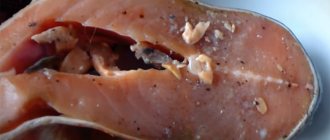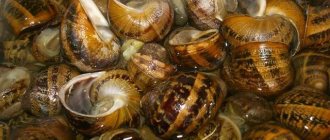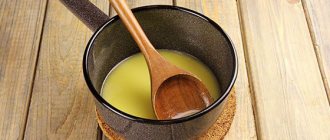Homemade horseradish with brine - recipe with vinegar
Cooking horseradish has several important features that must be taken into account. Otherwise, the process of preparing horseradish will be remembered as a bad dream, and the result, despite the efforts expended, will not live up to expectations.
- Horseradish roots, dug up in September, are suitable for preparing snacks; their length is 30-50 centimeters, and their diameter is from 3 to 6 centimeters.
- You shouldn’t prepare a lot of horseradish seasoning for future use: after a month of storage, it becomes noticeably less hot, and lovers of “vigorous” seasonings will no longer like it. The root itself can be stored in a cool and damp place for up to 6 months, so it makes sense to put the roots in the refrigerator and use as needed. However, if you don’t want to bother with preparing the snack every month, you can still prepare it for the winter, since it can be stored in sterilized, hermetically sealed jars for at least 4 months. In addition, some recipes allow you to prepare an appetizer from horseradish that can even be stored in the pantry for a very long time (up to a year).
- If the horseradish root has waited too long in the wings, it will almost certainly dry out. In this regard, before processing it should be soaked in cool water for several days (from three to seven).
- To improve the storage of prepared horseradish, it should be placed in sterilized jars and hermetically sealed.
- The esters released when working with horseradish strongly irritate the mucous membranes and cause lacrimation. Horseradish will be a little less aggressive if you put it in the freezer for a couple of hours before processing. It will be easier to grind it with a meat grinder if you attach a plastic bag to it to collect the finished horseradish mass. It is safer to work with horseradish while wearing gloves.
Even on store shelves you can find horseradish prepared according to different recipes. There are even more recipes for homemade horseradish. It makes sense to prepare horseradish seasoning according to at least two or three popular recipes, especially since they are all different.
Classic horseradish is a traditional dish of Russian cuisine. If made with vinegar, it can be stored for a very long time. A classic homemade addition to meat, fried (baked) fish and jellied root meat with a strong aroma, it is very easy to prepare. In a blender, the root will be easily crushed and you won’t have to cry.
Ingredients:
- horseradish root – 400 grams;
- boiled water – 500 ml;
- white wine vinegar – 200 ml;
- sugar – 1 tbsp. l.;
- salt – 1 tbsp. l.
Cooking recipe step by step:
- Remove the skin from the root using a knife and cut it into pieces.
- Transfer to a blender and grind.
- Pour boiling water over the pureed mixture and let it brew for 5 minutes.
- Add vinegar, sugar, salt. Stir the appetizer until smooth.
- Fill a clean container with sauce and place it in the refrigerator for storage.
You can use this adjika without cooking it as a seasoning for dishes or prepare homemade tomato sauces based on it.
Horseradish with tomato and garlic is a delicious combination of spicy sauce without cooking. Tomatoes thin out the thickness of the grated horseradish and soften the spiciness of the appetizer. Tomato-horseradish dressing is good for seasoning borscht and meat dishes.
Ingredients:
- tomatoes – 2 kg;
- horseradish (root) – 300 grams;
- salt – 2 tbsp. l.;
- garlic – 200 g;
- sugar – 1 tbsp. l.
How to cook at home:
- Wash the tomatoes and dry thoroughly with a paper towel.
- Remove the stems from the tomatoes and cut the vegetables into four parts.
- We grind them in a meat grinder, pour the natural tomato juice along with the tomatoes into a deep bowl.
- Peel the garlic and the garlic root and grind it in a blender to a fine paste.
- We send the horseradish mass to the tomatoes.
- Add salt and sugar. Mix everything.
Pour the mixture into clean and dry jars and close tightly. Store in the refrigerator like regular classic sauces.
Horseradish with beet juice (buryak) or sauce with horseradish and beets (beet kvass) has an appetizing pink color and is considered a classic dish for a meal on Christmas Eve on the eve of the Nativity of Christ in Ukraine. Ukrainian horseradish recipes, as a rule, consist of spicy horseradish with beets, a vigorous, chilled sauce that warms the cold winter.
With raw beets, horseradish is marinated in beets with vinegar - the hottest and hottest. The appetizer-condiment, in addition to its excellent taste, is very healthy, rich in vitamins (horseradish contains more vitamin C than lemon) and the sauce goes well with all meat and fish dishes. It is spread on bread and eaten with borscht, meat solyanka, classic okroshka and cold beetroot soup. Preparing horseradish sauce with beets according to the classic recipe is as easy as shelling pears.
Ingredients:
- horseradish (root) – 200 grams;
- fresh beets – 100 grams;
- vinegar 9% – 3 tbsp;
- water – 200 ml;
- sugar – 1 tbsp;
- salt – 1 tsp.
How to cook horseradish with beets:
- First of all, cook the marinade. To prepare it, pour water into a saucepan, add salt, sugar and vinegar.
- Boil for a couple of minutes and let cool.
- We clean and wash the beets and horseradish, grate them on a fine grater
- Pour the warm marinade into the grated beets and horseradish.
- Mix everything and transfer it to a jar. Close the lid.
- After the marinade has cooled, put the jar in the refrigerator. Let the horseradish sit for a day.
We use the ready-made homemade sauce as an additive to a classic vinaigrette, add it to mayonnaise dressings for spiciness and pink color, or leave it for preparation for the winter. Try making horseradish with beets, marinated at home.
This option is convenient because you don’t need to measure the amount of horseradish; just dilute the twisted mass with brine to the required consistency. This time it is better to use a blender. With its help, you will make the most homogeneous sauce, no worse than store-bought. It will be pure white in color, spicy but pleasant to the taste.
Ingredients:
- horseradish;
- 800 ml water;
- 50 ml vinegar 9%;
- 4 tsp heaped sugar;
- 2 tsp salt.
Horseradish for the winter: classic recipe
The main thing in preparing for the winter is that the product does not ferment, and for this they use a technique such as sterilization. Ingredients required for preparation:
- Horseradish, fresh or from the freezer – 1 kg;
- Boiled water – 1 glass;
- Vinegar – 150 g;
- Coarse salt – 1 tbsp;
- Sugar – 1 tbsp.
Equipment and accessories:
- Food processor;
- Small glass jars;
- Screw caps;
- Wide saucepan.
The process of preparing horseradish for the winter according to the classic recipe:
- Soak the rhizomes for several hours, peel and cut into 3-4 cm pieces.
- Pass through a meat grinder or grind in a food processor (blender).
- Dissolve salt and sugar in a glass of water, pour in vinegar. For better dissolution, it is recommended to let the brine boil.
- Cool the solution, pour into chopped horseradish, mix.
- Place the mixture in jars, cover with lids, and sterilize.
After the sterilization time has expired, the jars are carefully removed from the water and the lids are screwed on.
If your family loves horseradish, take any recipe: classic, with beets, apples or tomatoes and prepare a delicious seasoning at home. It will be cheaper and tastier than the one from the store. Before serving, you can add mayonnaise or sour cream to the classic version and the one with beets.
Hello, dear readers of my blog! Tell me, how many of you are spicy lovers? My husband doesn't sit down at the table without horseradish sauce. Seasons meat, jellied meat, okroshka and dumplings with it. To make it not only tasty, but also natural, I found how to cook horseradish at home. It turned out to be very simple and can be stored all winter. Moreover, there is no shortage of this plant. I myself like to add such a strong snack to sour cream sauces, borscht, potatoes, stewed cabbage, or just lightly grease a piece of bread.
Homemade horseradish
Many housewives know how to make homemade horseradish at home, especially if they grow their own plantings of fresh horseradish in the garden. Fans of spicy tastes often buy canned table horseradish in the store, which is inferior in taste to homemade natural sauce. It’s easy and simple to prepare this spicy pasty snack with your own hands at home.
To prepare homemade horseradish, use paste-like horseradish, beets, garlic, apples, tomatoes and add vinegar, oil, mayonnaise, cream or sour cream to the grated horseradish mass. Our grandmothers made homemade seasonings of varying degrees of pungency from grated horseradish during Soviet times. Classic Soviet-era recipes have been supplemented with new recipes for preparing the seasoning. Previously, not a single holiday was complete without horseradish.
Horseradish and horseradish have long been snacked on at festive feasts, added to okroshka and meat. Our ancestors were treated for coughs with compresses made from horseradish minced in a meat grinder. In the old days, with the help of a useful plant, they got rid of colds and arthrosis. Men regained their strength thanks to the healing properties of the root. Horseradish tinctures were prepared in every home in Rus' and drunk as a medicinal infusion.
How to quickly prepare grated table horseradish with mayonnaise at home?
Table horseradish is prepared at home through a meat grinder. Lemon juice acts as a preservative in the horseradish recipe without vinegar. To get classic tender horseradish puree, the root is passed through the smallest nozzle of a meat grinder. Lemon juice keeps the classic sauce white, just like in the store.
Ingredients:
- horseradish – 1 kg;
- water – 250 ml;
- salt – 30 g;
- sugar – 50 g;
- lemon juice – 20 ml.
Cooking method:
- Grind the prepared horseradish by passing it through a meat grinder.
- Mix the chopped root with salt and sugar.
- Pour boiling water over the horseradish and stir.
- Fill small jars with seasoning. Pour lemon juice into each jar at the rate of 1 teaspoon per small 200 ml jar.
- We close the jars and put them in the refrigerator.
Horseradish prepared according to the classic recipe can be stored for 1-2 months. For longer storage, it is better to use a horseradish recipe with vinegar.
Horseradish with apples
The juicy and appetite-stimulating seasoning will complement the sweet composition of the kholodnik with its pungent taste, giving the cold borscht a spicy and piquant flavor. You need to prepare horseradish in advance - a couple of hours before serving it with boiled tongue or festive aspic.
Ingredients:
- horseradish root – 100 grams;
- apple – 200 grams;
- meat broth – 100 ml;
- vegetable oil – 30 ml;
- apple cider vinegar – 30 ml;
- salt - to taste.
- We pass the peeled horseradish through a meat grinder.
- Mix the pulp with grated apple.
- Pour in homemade broth, oil, vinegar. Salt and mix everything.
This horseradish is moderately spicy and very aromatic, but can be stored for no longer than 2 days. When serving, the dressing can be supplemented with mayonnaise.
Horseradish with mayonnaise
Anyone can quickly prepare grated horseradish with mayonnaise. It’s better to take homemade mayonnaise, but store-bought mayonnaise is also suitable for quick preparation. Mayonnaise will add a creamy taste and turn the mildly spicy snack into a creamy paste with a delicate consistency. Mayonnaise in the recipe can be replaced with sour cream.
What you will need:
- horseradish (root) – 100 g;
- lean mayonnaise (or sour cream) – 100 grams;
- sugar – 10 g;
- salt - to taste.
- Grind the peeled horseradish.
- Mix it with mayonnaise, salt and add sugar.
The sauce is ready without cooking and can be served. It turns out to be a very interesting taste. This horseradish tastes great for seasoning sauerkraut without cooking, or dipping baked goods with meat into it.
Horseradish prepared according to this recipe is not suitable for long-term storage, unlike the classic recipe with vinegar.
I always have a jar of this sauce in my refrigerator. It is sharp, vigorous, and perfectly whets the appetite. It is also a good antiseptic. Our family uses it regularly, but in reasonable quantities. I add beets for taste, beautiful color and benefits.
To prepare, take:
- 5-6 fresh horseradish roots;
- 1 raw beets;
- 1 tbsp. Sahara;
- 1 tsp salt;
- 1 tbsp. vinegar.
1. Peel the root, rinse, cut into slices and pass through a meat grinder.
2. Then, cut the beets into pieces and twist them.
3. Add sugar, salt and vinegar directly into the plastic bag with chopped root vegetables. Stir and transfer into small jars.
4. Pour boiling water over the contents of the jars, wait until they cool completely and put them in the refrigerator for 12 hours.
This amount makes approximately two half-liter jars of snacks. The appetizer goes well with baked pork knuckle.
Fermented beet kvass allows you to do without vinegar. It makes a delicious pasty snack. It is better to store it in small jars - the more often you open them, the faster the strength will be lost.
You will need:
- 550 g horseradish;
- 500 ml beet kvass;
- 2 tbsp. Sahara;
- 1-2 tsp. salt.
1. Divide the roots into small pieces. Twist them in a meat grinder with a fine grid, after placing a plastic bag over the outlet hole. Remove and tie the bag immediately so as not to release the burning fumes.
2. Prepare beet kvass, salt and sugar. Place the chopped horseradish in a bowl and immediately pour kvass over it. Add salt, add sugar and mix well. Taste for salt, add another 1 tsp if necessary.
3. Divide the mixture into jars, add 1-2 tbsp on top. beet kvass.
4. For beet kvass: fill a three-liter jar ⅔ full with large pieces of beets, add 1 chopped horseradish root. Fill to the top with clean (not chlorinated) water, pour in 1 tbsp. 9% vinegar. Leave to ferment for 3 days – a light foam will appear on top. Then store in a cool place. Bon appetit!
Add a little sauce to stewed pork with vegetables, the taste will be more spicy and rich.
A very tasty sauce based on two hot ingredients - horseradish and garlic. You can't get any more piquant! To soften the harshness of the first one a little, you can pour boiling water over it. With tomato, the taste becomes more balanced, and the sauce acquires a delicate and juicy consistency.
And on a grater, the root will be grated quickly and easily if you follow the little secret described in the recipe. Mayonnaise is added for taste and to give it a creamy consistency. And not vinegar, but lemon juice is used as a preservative.
Required Products:
- 2 small roots;
- 200 ml boiled water;
- 1 tbsp. dietary mayonnaise;
- 1 tbsp. lemon juice;
- 1 tsp Sahara;
- 1 tsp salt.
1. Peel the root and rinse. Place in the freezer for half an hour, then grate on the finest grater. Add mayonnaise and stir. You will get a paste-like mass. Transfer it to a jar.
2. Dilute lemon juice with water, add salt and sugar. Stir until dissolved and begin to gradually pour into the twisted mass. Stir and watch the consistency - it should turn out like semolina porridge. Taste and, if you think necessary, add more salt or sugar.
It turns out very tasty, be sure to cook it. I recommend serving with baked meatloaf.
How do you like this unusual combination of horseradish, honey, beetroot and lemon juice? The menu is interesting and varied. A very tasty natural homemade snack.
Prepare for the recipe:
- a bunch of horseradish roots;
- ½ lemon;
- ⅔ glass of beet juice;
- 1 tbsp. honey;
- 1 tsp salt.
1. Peel the roots and cut into small pieces. Scroll them through a meat grinder into a bag. Better 2 times.
2. Transfer the crushed mass into a jar, squeeze out the juice of half a lemon and add beet juice. Add honey and salt. Mix everything well.
The sauce is ready, take a sample!
Now you know several ways to make quick and easy horseradish root sauce. There is no doubt about its benefits and naturalness. Share these solutions with your friends. Surely, many people have leftover roots in the refrigerator after salting that have no use. Delicious meals and good health to you! See you again!
Sincerely, Olga Sologub
Cooking horseradish at home will allow you to stock up on the hot seasoning for the winter. It is served with aspic, jellied meat, jelly, homemade sausages and other dishes.
Horseradish in Russian
Horseradish root (1 kg) is peeled and washed. Grate it on a fine grater or grind it in a meat grinder. Add salt (1 tbsp), sugar (3 tbsp), and boiling water (1 cup). The ingredients are quickly mixed and placed in sterile jars. Add 2-3 drops of lemon juice to each jar on top. If the jars are sealed with canning lids, horseradish will be stored in the refrigerator for up to 3 months.
This horseradish preparation is served either in its pure form or diluted with sour cream in a ratio of 1 to 1. It is an ideal addition to boiled potatoes, jellied meat, jellied meat, and meat dishes.
Horseradish with beets
Beetroot horseradish is a well-known horseradish recipe that can be easily prepared at home even by inexperienced housewives. The seasoning turns out bright, stimulating the appetite.
• Fresh horseradish root (10 pieces medium size);
• Raw beets (1 pc.);
• Salt and sugar to taste;
• Wine or apple vinegar (5-6 tablespoons).
Horseradish and beets are ground on a grater or in a meat grinder. Add salt and sugar to taste, and at the very end - vinegar. If the seasoning is too thick, you can add cold boiled water to the desired consistency. The seasoning is mixed, placed in jars, tightly closed with lids and placed in the refrigerator. This “evil” seasoning will remain for a month.
Advice
If there is no need to store horseradish and beets for a long time, you do not need to add vinegar.
Cooking horseradish at home, the recipe for which we will now tell you, is popular among lovers of spicy hot sauces.
• 1 kg of tomato is ground in a meat grinder;
• Next, 300 g of horseradish root and garlic are chopped into a meat grinder or grater;
• Add 1 tbsp. l. salt and sugar and 2-3 tbsp. wine vinegar, or 1-2 tbsp. l. table vinegar 9%;
• The finished sauce is poured into sterile jars and tightly closed with lids.
Store in a cool place.
Recommendation
The proportions of ingredients should be adjusted to your taste.
For example, increase the amount of garlic or add more sugar. • 2 kg of carrots are grated on a fine grater;
• Prepare 100 g in the same way. garlic;
• 100 gr. apples (Antonovka, Semerenko) cut into thin slices;
• Place apples, carrots, horseradish in layers in a jar and fill with marinade.
• Boil 1 liter of water with 3 tbsp. sugar and 1 tbsp. salt. At the end add 2 tbsp. vinegar 9%;
• Sterilize prepared jars with salad for 15-20 minutes and roll up.
Compound:
- horseradish – 1 kg;
- water – 0.25 l;
- salt – 30 g;
- sugar – 50 g;
- lemon juice – 20 ml.
- Peel the prepared horseradish, chop it by passing it through a meat grinder. Use a nozzle that allows you to get the most fine and delicate consistency, similar to puree. Don't forget to attach a bag to it to at least partially protect your eyes from the pungent odor.
- Mix chopped horseradish root with salt and sugar.
- Boil water and pour boiling water over the horseradish, stir.
- Sterilize very small jars and place the seasoning in them. Pour a little lemon juice into each jar: no more than a teaspoon per 0.2 liter jar, but not less than two milliliters. The juice will act as a preservative and at the same time prevent the horseradish from darkening. However, you don’t need a lot of juice to prevent the seasoning from turning out sour—according to the traditional recipe, it shouldn’t be.
- Close the jars tightly and place in the refrigerator.
Classic homemade horseradish recipe
- horseradish – 1 kg;
- water – 0.25 l;
- salt – 30 g;
- sugar – 50 g;
- lemon juice – 20 ml.
- Peel the prepared horseradish, chop it by passing it through a meat grinder. Use a nozzle that allows you to get the most fine and delicate consistency, similar to puree. Don't forget to attach a bag to it to at least partially protect your eyes from the pungent odor.
- Mix chopped horseradish root with salt and sugar.
- Boil water and pour boiling water over the horseradish, stir.
- Sterilize very small jars and place the seasoning in them. Pour a little lemon juice into each jar: no more than a teaspoon per 0.2 liter jar, but not less than two milliliters. The juice will act as a preservative and at the same time prevent the horseradish from darkening. However, you don’t need a lot of juice to prevent the seasoning from turning out sour—according to the traditional recipe, it shouldn’t be.
- Close the jars tightly and place in the refrigerator.
Horseradish prepared at home according to the classic recipe can be stored for no more than 4 months, but it is still better not to risk it and eat it a month or two before. If you plan to store the product all winter, it is better to choose a different recipe, with vinegar.
How to grate horseradish
When working with horseradish, it is known that severe lacrimation occurs. To avoid crying from the burning essential oils released from horseradish, it is better to use gloves, take precautions and follow simple rules.
- Horseradish will remain vigorous, but will become less aggressive during cooking if it is frozen first.
- You can soak the horseradish roots in cold water for a couple of hours (longer if time permits), then it will be easier to work with them. Soaking makes the cooking process easier and adds juiciness to the dried horseradish.
- Grinding horseradish with a blender will be easier than with a meat grinder.
- Grinding in a meat grinder will take place without tears if you tightly tie a bag of cling film to it to collect the grated horseradish pulp. This method of protection allows you to protect your eyes from the pungent odor that causes tears.
- If you freeze the horseradish in advance, the root will be grated easily and without tears.
A natural homemade snack made from horseradish, beet juice and vinegar is suitable for long-term storage. A jar of this sauce will help out the housewife when she needs to diversify a simple dinner or a quick Lenten menu.
500 ml
40 min
70 kcal per 100 g
Ingredients:
- horseradish root – 400 grams;
- beet juice (from raw beets) – 50 ml;
- water – 150 ml;
- table vinegar 9% – 150 ml;
- sugar – 20 grams;
- salt – 30 grams.
- Soak the peeled horseradish roots in cool water, cutting into pieces. Leave for several hours.
- Insert a wire rack with small holes into the meat grinder and secure it with a thick cling film bag. A freezer bag works well.
- Grind the horseradish into the bag through a meat grinder.
- Pour boiling water over the grated horseradish, add salt and granulated sugar. Mix the horseradish mass.
- Grate the peeled fresh beets on a fine grater and squeeze out the juice.
- Pour vinegar with beet juice into horseradish. Stir.
- Transfer the seasoning into clean, sterilized jars.
- We close it tightly and put it in the refrigerator or cellar for storage.
In the refrigerator, the shelf life of a snack with vinegar is about a year, but the longer horseradish is stored, the softer its taste becomes, and its pungency disappears over time.
Homemade horseradish with beet juice
- horseradish root – 0.4 kg;
- water – 0.15 l;
- table vinegar (9 percent) – 0.15 l;
- sugar – 20 g;
- salt – 30 g;
- beet juice – 50 ml.
- Prepare the horseradish roots by soaking them for several days in cool water, peeling them and cutting them into pieces.
- Screw a nozzle with small holes onto the meat grinder, attach a plastic bag to it, preferably a thick one (for example, intended for freezing food).
- Grind the horseradish into the bag through a meat grinder.
- Pour boiling water over the horseradish, add salt and sugar and stir.
- Finely grate or mince raw (peeled) beets and squeeze out the juice. Measure out 2-2.5 tablespoons of beet juice and mix it with vinegar.
- Pour the vinegar and beet juice into the horseradish and stir.
- Prepare the jars by washing them with baking soda and sterilizing them.
- Place the seasoning in jars, seal them tightly and place them in the refrigerator or just in a cool place.
In the refrigerator, such a snack can be stored for a whole year, outside the refrigerator - up to six months. At the same time, you need to be prepared for the fact that vinegar and long-term storage will do their job - the horseradish will become milder in taste. But thanks to beetroot juice, the appetizer will acquire a pleasant pink color and can decorate the table.
How to make horseradish with tomatoes at home?
Compound:
- horseradish – 1 kg;
- tomatoes – 1 kg;
- garlic – 3 cloves;
- sugar – 40 g;
- salt – 20 g.
- Wash the tomatoes, pour boiling water over them, peel and cut into 4 parts.
- Peel the soaked roll and cut into small pieces.
- Peel the garlic and pass through a press.
- Prepare the meat grinder by attaching a thick plastic bag to it.
- Place several pieces of horseradish and tomatoes into the meat grinder one at a time and crank them until you run out. If the bag becomes full early, change it and then mix the contents of both bags.
- Add salt, sugar, garlic to the tomato-horseradish mixture and stir well.
- Place in clean, dry jars, roll them up or screw on the lids. Put it in the refrigerator for the winter.
If stored in the refrigerator, homemade Chrenoder will easily last for 9 months; if you manage to eat it in six months, even better. The snack turns out to be spicy, juicy and very healthy.
Horseradish with apples
Compound:
- horseradish root – 100 g;
- apple – 0.2-0.25 kg;
- meat broth – 100 ml;
- vegetable oil – 30 ml;
- apple cider vinegar – 30 ml;
- salt - to taste;
- parsley (optional) – 50 g.
- Prepare the horseradish and pass through a meat grinder.
- Mix with grated apple.
- Chop the parsley and add to the horseradish.
- Pour in the broth, oil, vinegar, salt and stir.
This horseradish should be prepared several hours before serving and in small quantities. It turns out soft, aromatic, but does not last long - no more than two days.
Seasoning roll
After the seasoning is prepared, it must be removed from the stove, and then added refined oil and apple cider vinegar. After mixing the ingredients with a large spoon, they should be placed hot in sterilized jars and immediately sealed tightly.
After cooling the seasoning at room temperature, it must be put in the pantry or some other cool place where it can be stored for six months. It is recommended to consume such a flavorful and high-calorie snack 1-2 months after the actual seaming.
You can serve beetroot seasoning with horseradish with any second or first courses. In addition, some housewives often add it to borscht or use it as a snack salad, spread on a thin slice of bread.
Homemade horseradish with brine - recipe with vinegar
Homemade horseradish with brine and its ancient recipe are interesting because of the simplest composition for preparing the hottest sauce using brine from tomatoes and pickled cucumbers for the winter. Horseradish appetizer marinated in brine turns out homogeneous if the horseradish root is crushed using a blender, and very spicy with cucumber brine.
How to cook:
- We wash the roots and soak them for 20 minutes in cold water.
- Dry and place in the freezer for a couple of hours.
- We scroll the frozen root through a meat grinder or grind it with a blender.
- Transfer the grated horseradish into a glass jar.
- Pour cucumber brine over the horseradish and add sugar.
The ancient sauce is ready immediately, and you can start tasting it. But you can let it brew for about 12 hours and make its taste spicy-burning, better than store-bought with cream.
Creamy horseradish
Creamy horseradish (or horseradish with cream) is one of the best creamy horseradish and cream sauces. The horseradish cream sauce will take a maximum of 15 minutes to prepare. The recipe is quick and easy to make. The additive is ideal for the holiday table.
Ingredients:
- grated horseradish – 3 tbsp;
- cream – 200 ml;
- chicken eggs – 2 pcs.;
- lemon juice – 2 tbsp;
- vegetable oil – 2 tbsp;
- sugar and salt - to taste.
Step-by-step preparation:
- Boil the eggs hard and cool. We grate them on a fine grater.
- Add lemon juice to the eggs, a pinch of sugar and salt and pour in the cream.
- Beat the mixture with a mixer.
- Add grated horseradish to the cream and whisk the sauce until smooth.
- Let it brew for 2 hours in the refrigerator.
The prepared dressing is immediately ready for use and can be stored longer due to the natural preservative – lemon.
The classic combination of horseradish with honey, lemon and beet juice will soften the pungency inherent in the root. The homemade snack is 100% natural and very, very tasty.
Product composition:
- lemon – half a fruit;
- a bunch of horseradish roots;
- beet juice – 4-5 tbsp;
- honey – 1 tbsp;
- salt - to taste.
How to do:
- We thoroughly clean the roots and cut them into pieces.
- We pass them through a meat grinder twice to make the crumbs fine.
- Transfer the pulp into a jar and fill it with lemon and beet juice.
- Add honey and a pinch of salt.
- Mix carefully and the quick seasoning sauce is ready.
Spicy horseradish with garlic turns out spicy and very healthy. Horseradish and garlic are natural, powerful preservatives; dishes made from them are healthy and can be stored in the refrigerator for a long time without losing their beneficial and taste qualities.
- fresh horseradish – 200 grams;
- garlic – 7 cloves;
- sugar – 1 tsp;
- salt - half a teaspoon;
- water - about half a glass.
Step-by-step cooking recipe:
- We take a fresh, juicy root dug from the garden or purchased horseradish from our grandmothers. If you bought it, it’s better to soak the horseradish so that it is juicy.
- Clean, wash and cut into pieces.
- Transfer to a blender bowl.
- Pour in half the water and grind in a blender. You can grind it through a meat grinder.
- Add the garlic cloves and the rest of the water. We punch it again with a blender.
- Pour sugar and salt into the resulting delicate consistency.
- Stir the horseradish and garlic for another 2 minutes.
Fill the jars with sauce and put them in a cool place. Let it brew and, if necessary, add a spoonful to soups, various salads, or use a healthy natural supplement for treatment.
Horseradish
is considered one of the best seasonings in world cooking , and only instability in storage prevents it from gaining the status of a fairly common product.
It is interesting that in the old days in Russian cuisine it was used with all cold and boiled types of fish dishes.
They also ate it with fish pies and kulebyaks, but not when they were, as they say, piping hot, but usually the next day, when they were already cold. Horseradish served with cold meat dishes (most often pork).
In classical Russian cuisine table horseradish was always made without vinegar, since they were sure that it “kills” the peculiar delicate, soft, piquant taste of horseradish, imparting its acetic-sour pungency and a different taste.
In addition, this seasoning was made, so to speak, directly to the table. They tried not to leave her for more than one or two days. This version of table horseradish is given the name “Russian table horseradish”.
There was even a certain ritual for its use. Table horseradish was taken into the mouth only after biting off and lightly chewing a piece of meat or fish. Foreigners, as a rule, were not familiar with this secret. Therefore, in this way it was easy to recognize a non-Russian person.
It turns out that in ancient times in Rus' there was also a custom associated with the “skill” of eating horseradish. It was used to check the bride and groom. The dominance of horseradish seasoning in Russian cuisine remained almost until the beginning of the twentieth century.
Its use had not only nutritional, but also preventive value, because the Russian version of table horseradish made it possible to preserve all the bactericidal properties of the base product, that is, horseradish, and was an effective means for preventing scurvy, colds and infectious diseases of the upper respiratory tract, and also contributed to the prevention intestinal disorders.
Table horseradish , which contains vinegar, is called “horseradish in Polish.” This version of the seasoning was popular in Volyn, Belarus and Lithuania.
Horseradish seasoning with vinegar, tinted with beet juice, is also typical for Transcaucasian cuisine. True, a stronger solution is added there, that is, a 1.5% solution of wine vinegar.
Homemade horseradish recipes
Recipe for Russian table horseradish
Grocery list:
- horseradish root
- 1 piece refined sugar
- 1 pinch of salt
- a little cold boiled water
- sour cream
Cooking process:
- The horseradish root is peeled using a knife. It is not recommended to wash it. As a last resort, if it is very dirty, after finishing cleaning it can be rinsed under running cold water.
- Then the peeled root is grated on a fine grater. As you grate, portions of horseradish should be transferred to a previously prepared glass or porcelain jar, with a little cold boiled water poured into the bottom. This will prevent the grated portions of horseradish from drying out in the open air.
- When the process of rubbing the root is completed, you need to add a little more cold boiled water to the grated mass so that the mass acquires the consistency of a thick gruel, and add salt and sugar.
- The small pieces of horseradish root remaining after grating also need to be placed in a jar with the grated mass, turning with a tablespoon so that they end up at the bottom of the container.
- Each tablespoon of this preparation must be diluted with a dessert spoon of sour cream before serving.
Note:
- It is better to grate horseradish root on the balcony or on the street, or at least in a room where the window is open, since the smell that horseradish spreads during this process is not only too strong, but also very pungent and pungent.
- It would be nice to add grated lemon zest or lemon juice to this version of table horseradish, respectively reducing the amount of cold boiled water added.
- This preparation should not turn out watery. It should be thick, that is, have the consistency of a viscous porridge.
- Only on the second or third day, when the prepared horseradish begins to experience a decrease in pungency, can you add a little 0.5 percent vinegar.
Polish table horseradish recipe
Grocery list:
- 150g horseradish roots
- 0.5 tbsp plain water
- 1 tbsp granulated sugar
- 0.25 tbsp vinegar (9 percent)
- 3 tsp salt
Cooking process:
- Horseradish roots are thoroughly cleaned and grated.
- You need to boil the water, add granulated sugar, salt and vinegar to it, wait until it cools down, and then pour it over the horseradish.
Note:
- When making table horseradish according to this recipe, you can increase the amount of water and vinegar. You can also add less salt and more granulated sugar to taste.
- When using this preparation for dressing salads, you can add sour cream, finely grated boiled beets, grated sour apples, pickled lingonberries, mayonnaise, honey, cream.
Horseradish with sour cream
Compound:
- horseradish (root) – 100 g;
- sour cream – 100 g;
- sugar – 10 g;
- salt - a pinch.
- Peel and chop the horseradish.
- Mix with sour cream, salt and add sugar.
Horseradish prepared according to this recipe is also not intended for long-term storage. It will not be too spicy and will appeal to those who do not like the too “vigorous” taste of fresh horseradish.
Homemade horseradish is a traditional seasoning for meat and fish dishes. If you cook it with vinegar, it can be stored for a long time. However, many housewives do not prepare it for future use, since over time it loses its burning properties.










